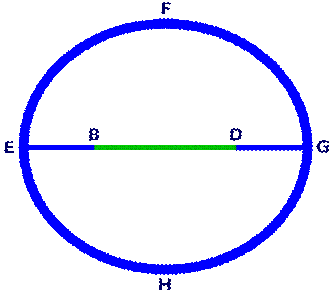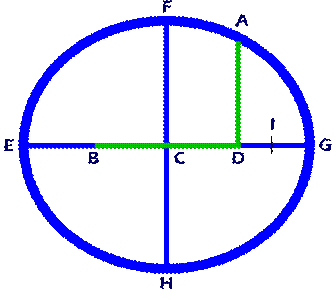|
|
|||||||||||||||||||||||||||||||||||||||||||
|
|
|||||||||||||||||||||||||||||||||||||||||||
|
|
T |
|
|||||||||||||||||||||||||||||||||||||||||
|
|
|||||||||||||||||||||||||||||||||||||||||||
|
|
|||||||||||||||||||||||||||||||||||||||||||
|
|
T |
|
|||||||||||||||||||||||||||||||||||||||||
|
Begin
with a line BD of
any
length.
Or, an
ellipse of
any
shape. (See: further below)
Extend
line BD by one-half with line EB.

Construct an ellipse EFGH
with points B and D as the foci and
line EB as the perigee.
Thus, line ED is the apogee.
Draw
line DG which will equal line EB.

At the
midpoint, C, of line BD,
draw line FH perpendicular to line BD.
Line FH intersects ellipse EFGH at points F and H.
At focus D,
draw line AD perpendicular to line BD.
Line AD intersects ellipse EFGH at point A.
Bisect line DG at Point I.
Line DI equals line GI.
|
|
Draw Line AB.
Draw Line BF.
The
definition of an ellipse is
a plane curve comprised of a
locus of points such that
the sum of the distances from
every point on the locus to
two fixed points is equal.
Thus, line AB plus line AD equals
line BE plus line BG, which equals
two times line BF, and so on.
Points B and D are the fixed points of
ellipse EFGH, each of which is a focus.
If
line DI equals one, 1,
line DG equals two, 2.
By the definition of an ellipse:
lines AB plus AD equal eight, 8,
as they are twice line CG
that is twice line DG.
Triangle ABD is a right triangle;
thus, line AD equals, three 3;
line BD equals four, 4; and,
line AB equals, five 5.
Line BG equals, six 6;
line EI equals, seven 7; and,
line EG equals, eight 8.
If
line EG equals eight, 8,
line BF that is drawn from
a focus to a midpoint equals four, 4.
From a line of
any
length
the Natural integer values of
the first eight integers
are established from an ellipse
that is seminal phenomenon;
such that a value of one
is established,
within the system of numbers,
without a predetermined base.

To
summarize:
EFGH, E,
is an ellipse if
line BE plus line BG equals
line DE plus line DG equals
line AB plus line AD equals
2 times line BF equals
line EG.
BE + BG = DE + DG =
AB + AD = 2 x BF = EG.
And, if line AD is perpendicular to line BD,
line AB equals the square root of the
sum of line AD squared plus line BD squared.
Substituting the above line values:
2 + 6
= 6 + 2 =
5 + 3 = 2 x 4 = 8.
And, 5
= square root (9 + 16).
Let
line DI, equal one, 1; and,
line BE, 2,the perigee, p, = x; then,
line BF, 4, the vector, v, equals x2;
line BC, 2, the soliton. s, equals x2 x;
line BD, 4, the wave, w, equals 2s;
line AD, 3, the radius, r, equals 2x 1;
line AB, 5, the hypotenuse, h, equals w + 1;
line BG, 6, the apogee, o, equals w + x;
line
EI, 7, the glyph, g, equals o + 1;
line GI, 1, the key, k, equals p 1;
line oP, 1, the hypotenuse radius, Hr, equals k;
line
EG, 8, the major diameter, M, equals o + p;
Line
DI is referred to as
epsilon,
e.
|
epsilon,
e,
equals h w = One |

The
radius, oP, of
a circle inscribed within
a right triangle equals
the product of the sides
that are opposite the hypotenuse
divided by the sum of all the sides.
oP = (AD x BD) / (AB + AD + BD)
Or, more simply, the diameter of
a circle inscribed within
a right triangle equals
the sum of the two sides
that are opposite the hypotenuse
minus the hypotenuse.
2 x oP = AD + BD AB
Line
oP, hypotenuse radius, Hr,
equals: (3 x 4) / (3 + 4 + 5) = 1.
2
times Line oP, hypotenuse diameter, Hd,
equals: 3 + 4 5 = 2.
|
Or, most simply, |
Thus
the hypotenuse radius, Hr, is an integer,
as are the: perigee, p, soliton. s,
vector, v, apogee, o, radius, r,
wave, w, hypotenuse, h,
glyph, g, key, k,
and major diameter, M.
|
Amazingly, all the above equations |
|
And,
of great significance, |

Line FC, is the amplitude, a.
When
the ellipse is a Brunardot Ellipse (BE)*,
and the amplitude is an integer; then,
ellipse EFGH is a Pulsoidal Ellipse (PE).
*
See: below for a definition.
The
following are some Pulsoidal Ellipse
integer values if perigee, p, equals 5;
the vector, v, equals p2 = 25;
the soliton, s, equals p2 p = 20;
the wave, w, equals 2s = 40;
the hypotenuse, h, equals w +
e
= 41;
the radius, r, equals 2p
e
= 9;
the amplitude, a, equals
p x the square root of r = 15;
the apogee, o, equals p + w = 45;
the glyph, g, equals o +
e
= 46;
the key, k, equals p
e
= 4;
the hypotenuse radius, Hr, equals k = 4;
the major diameter, M, equals 2v = 50.

Draw line GH.
At
focus B,
draw line BJ perpendicular to line BD;
Line BJ intersects ellipse EFGH at point J.
Draw line AJ.
Line FH is the minor diameter, A,
which equals 2a = 30;
Line BJ equals line AD the radius, r;
Line AC or CJ is the diagonal radial, d,
which quickly converges to s + 2 = 22;
Line AJ is the diagonal, D,
which quickly converges to 2d = 44.
Line GH is the diameter chord, c.

If the ellipse is a Brunardot Ellipse,
line oP, the hypotenuse radius, Hr,
equals an integer, k = 4.
If the ellipse is a Pulsoidal Ellipse,
interger values for the other
inscribed circles are:
Line oV, the vector radius, Vr,
equals an integer, (a p) / 2 = 5.
2 times line oR, the radial diameter, Rd,
converges to an integer, 2k
e
= 7.
2 times line oT, the chord diameter, Cd,
converges to an integer, 2Vr +
e
= 11.
|
All Brunardot Ellipses |
The
Elliptical Constant,
epsilon, e,
equals One, 1,
has, for
any
ellipse, many forms;
a few equations are:
e
= h w;
e
= 2p r;
e
= 2h r2;
e
= p Hr.
For
any ellipse,
when any of the above differences
equal one, or are set to one, which is the
Elliptical Constant, epsilon, e,
equals One, 1,
then, all the relationships, or equations that
relate the different parts of any ellipse,
are always the same set of equations that are
referred to as the Natural set of equations.
As the
perigee value increases
beyond a single digit
the following equation
quickly converges to
the Elliptical Constant,
epsilon, e,
equals One, 1:
e
= (d s)/2;
It can
be seen that the difference between
the diagonal, d, and the soliton, s,
quickly converges to
twice the Elliptical Constant.
Thus,
as the perigee increases to
a value beyond small integers,
the right triangle ACD has all sides as
integers with the difference
between the base and hypotenuse
equal to two, 2; or,
equal to twice the Elliptical Constant.
Right
triangle ACD is comparable to
right triangle ABD as it has all
integer sides; however, the difference
between the base and hypotenuse
equals the Elliptical Constant.
Also,
as
the perigee value increases
beyond a single digit for
any
ellipse
the following equations:
e
= Hd Rd; and,
e
= Cd Vd;
quickly converge to
the Elliptical Constant,
epsilon, e,
equals One, 1:
Virtually, the difference, epsilon, e,
between the hypotenuse diameter, Hd,
and the Radial diameter, Rd,
is minuscule;
the same is true for the difference, epsilon, e,
between the chord diameter, Cd,
and the Vector diameter, Rd.
These
convergence differences are
on the order of
much less than10-12
for even the smallest perigees.
Ultron
Ellipses (UE), are Pulsoidal Ellipses with
the chord, c as an integer.
Lemma
Ellipses (LE) are Ultron Ellipses with
the lemma, l, as an integer.
These
and other complex ellipses
are associated with elliptical bonding,
which is, heuristically, analogous to
subatomic and chemical bonding.

Line FK equals Line AB.
Line BK, is referred to as the lemma, l,
which is an integer; thus, 2 times radius oL,
the lemma diameter, Ld, is an integer.
The
Elliptical Constant can also
be constructed from
any
ellipse.
Or, a
line of
any
length. (See: beginning).

Begin
with
any
ellipse, EFGH.

Bisect line EG, the major diameter, M,
with a perpendicular line FH,
the minor diameter, m.

Draw line BF equals line CE or CG
from point F to point B in line EG.

Line DG equals line EB.
From point D draw line AD,
perpendicular to line EG,
to ellipse EFGH at point A.
Draw line AB.

The
Elliptical Constant, line DI,
equals line AB minus line BD.
Line
IG equals line DG minus line DI.

Draw line HG.
From
point B draw line BJ,
perpendicular to line EG,
to ellipse EFGH at point J.
Draw
line AJ.
Inscribe four circles in right triangles
ABD, BCF, BCJ, and CGH.
If line DI,
epsilon,
e,
= 1; and,
lines BE and DG, the perigee, p, = x = 13;
lines BC and CD, the soliton, s, p2 p = 156;
line BD, the wave, w, = 2s = 312;
lines BG and DE, the apogee, o, = w + p = 325;
line EI, the glyph, g, = o +
e
= 326;
line GI, the key, k, = p
e
= 12
lines AD and BJ, the radius, r, = 2p
e
= 25
lines CF and CH, the amplitude, a,
= p x square root of r = 65;
line BF, the vector, v, = p2 = 169;
line AB, the hypotenuse, h, = w +
e
= 313;
lines AC and CJ, the diagonal radial, d,
quickly converge to s + 2e
= 158;
line GH, the diameter chord, c,
quickly converges to s + r = 181;
line AJ, the diagonal, D, = 2d,
which quickly converges to 316;
line EG, the major diameter, M, = 2v = 338;
line
FH, the minor diameter, A, = 2a = 130.
Inscribed circle ABD is the hypotenuse circle.
Inscribed circle BCF is the vector circle.
Inscribed circle BCJ is the radial circle.
Inscribed circle CGH is the chord circle.
Line
oP, hypotenuse radius, Hr, = k = 12;
line
oV, the vector radius, Vr, = (a p)/2 = 26;
2 x
line oR, the radial diameter, Rd,
quickly converges to 2k
e
= 23;
2 x line oT, the chord diameter, Cd,
quickly converges to 2Vr +
e
= 53;
If epsilon,
e,
= One;
then, for
any
ellipse
perigee, p, equals x;
soliton, s, equals x2 x,
which is the Natural function;
vector, v, equals x2;
apogee, o, equals s + v;
radius, r, equals 2p
e;
wave, w, equals 2s;
hypotenuse, h, equals w +
e
or (r2
+ e)
/ 2;
glyph, g, equals o +
e;
key, k, equals p
e;
diagonal radial, d, converges quickly to s + 2e;
diagonal, D, converges quickly to 2d
amplitude, a, equals p x square root of r;
minor diameter, A, equals 2a;
major diameter, M, equals 2v;
diameter chord, c, converges quickly to s + r;
hypotenuse radius, Hr, equals k;
vector radius, Vr, equals (a p) / 2;
radial diameter, Rd, converges quickly to 2k
e;
chord diameter, Cd, converges quickly to 2Vr +
e.
If the
perigee, p, equals e;
the ellipse is a circle; and,
p, s, v, o are the first terms of
the
revised
Fibonacci sequence:
1, 0, 1, 1, ...
If the
soliton, s, equals e;
then,
the perigee, p, equals the Golden Ratio, F.
The Brunardot Theorem (BT)
states that for any ellipse:
the square of the diameter chord, c,
equals two times the square of the vector, v,
minus the square of the soliton, s.

c2 = 2v2 s2
A Conceptual Ellipse (CE)
is
any
ellipse when
epsilon, e,
equals One.
A Brunardot Ellipse (BE) is
a Conceptual Ellipse (CE) with a
perigee, p, equal to any Natural integer.
A Pulsoidal Ellipse (PE) is
a Brunardot Ellipse (BE) with an
amplitude, a, equal to a Natural integer.
An Ultron Ellipse (UE) is
an Pulsoidal Ellipse (PE) with a
diameter chord, c, equal to a Natural integer.
Conceptual Ellipses (CE) can be generated by
any
two positive numbers
that are referred to as
Time, T, and Cycle, C.
Circles and straight lines
are special ellipses where
the Time, T, and/or Cycle, C,
have infinite or infinitesimal values.
Brunardot Ellipses (BE) can be generated by
any
two Natural integers for the
Time, T, and Cycle, C.
Pulsoidal Ellipses (PE) can be generated by
any
Brunardot Ellipse.
Ultron Ellipses (UE), Lemma Ellipses (LE),
and other complex ellipses are
generated by predictable factors
that comprise the values for the
Time, T, and Cycle, C.
|
The
significance of ellipses lies in: |
|
3.)
The value of said integers are |
Formulas that apply to all ellipses and
circles inscribed in right triangles
that can be used to check values are:
The Brunardot Theorem
C2 = 2v2 s2.
The Pythagorean Theorem
a2 + b2 = c2.
The Inverse Square Law
v = p2.
Circles inscribed in right triangles
radius = (a x b) / (a + b + c)
diameter = a + b c.
Radial lines from a focus to
the circumference
2v = M
h + r = M
p + o = M.
A Fibonacci-like additive sequence
p,
s,
p + s = v,
s + v = o.
Of
additional interest:
The Elliptical Constant,
epsilon,
e,
= One, 1,
easily, makes possible
the construction of
the square root or
the square of
any
line.
Salient Natural set of Equations
derived from

The Brunardot Theorem
c2 = 2v2 s2
and
The Elliptical Constant,
epsilon,
e,
= One, 1, are:
T=
Time =
any
Natural Integer;
C= Cycle phase =
any
Natural Integer.
p = TC
v = p2
s = p2 p
w = 2s
h = w +
e
r = 2p
e
k = p
e.
And, for Pulsoidal Ellipses:
Ellipticalness = TC;
2TC
e
= Pulsoidal factor, F,;
r = F2;
a = Fp.
Page
25
|
|
|
|
T
|
|||||||||||||
|
|
|
|
|||||||||||
|
|
are a single discipline, which proclaims the |
|
|
|
perpetuity and nexus of Life; such is |
|
|
|
|
|
|
|
|
|
|
|
|